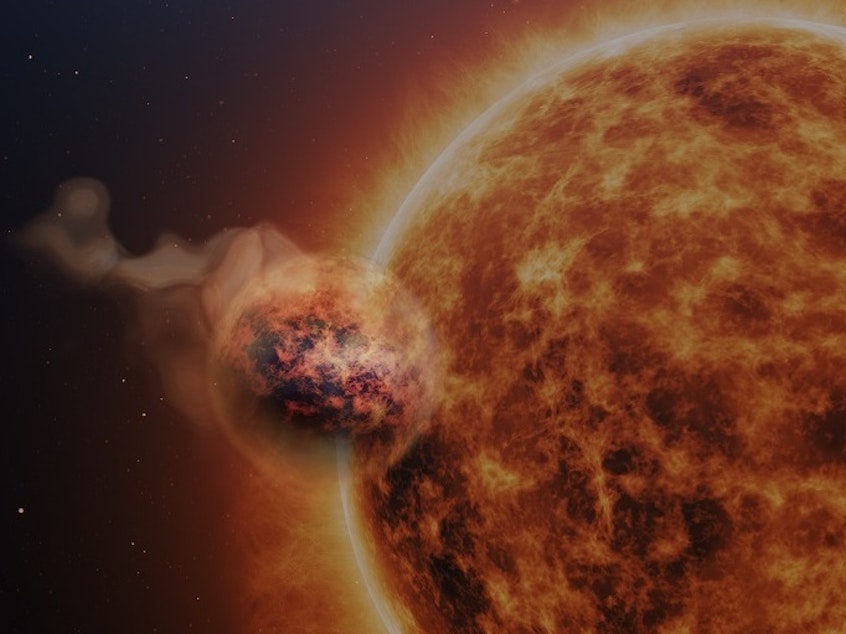Clouds made of sand make for a strange kind of rain on this hot planet

A faraway gas giant planet that's famous for being strangely "puffy" appears to have clouds that are made of tiny bits of sand.
The sand likely acts as water does on Earth, falling like rain towards the planet's hotter interior and then evaporating back up to form clouds once more, according to a new report published online by the journal Nature.
The discovery showcases one of the many kinds of bizarre clouds that scientists say probably exist out beyond our solar system.
Even though astronomers theoretically knew that clouds could form out of substances like rock or metal or salt, "now here we can actually look at it," says Laura Kreidberg, an astronomer at the Max Planck Institute for Astronomy in Germany who studies atmospheres of distant planets but was not part of this research team.
"It makes the weirdness of a cloud made out of rock feel so real," says Kreidberg.
She says scientists were eager to see what they might find when the James Webb Space Telescope (JWST) turned toward the oddball planet known as WASP-107b.
Discovered in 2017, this planet orbits a star about 212 light-years away that's a little smaller and cooler than the Sun. The planet is so close to its star that it orbits once every 5.7 days, and temperatures there reach around 900 degrees Fahrenheit.
Even though the planet is about the size of Jupiter, it is much lighter, with about the same mass as Neptune. Its low density led some scientists to call it a "cotton candy" or "super puff" planet.
"This is a very fluffy planet. And so the fact that it's so fluffy implies that we can really look very deep inside its atmosphere," says Leen Decin, director of the Institute of Astronomy at KU Leuven in Belgium and one of the lead scientists for this new study.
That's because starlight filtering through an atmosphere can reveal what it's made of, and the size of this atmosphere meant there'd be ample starlight to analyze.
In the past, scientists have struggled to understand the nature of clouds because they block the starlight from coming through.
"This happens a lot. Many of the planets that we have observed have really strong evidence for some kind of clouds or haze," says Kreidberg. "But up until now, it's been very difficult to determine exactly what type of cloud we're looking at."
With the powerful JWST, which peers at the universe in search of infrared light, scientists have a brand-new tool to help do that. Kreidberg explains that the tell-tale features from clouds are mainly in the infrared, which the Hubble Space Telescope couldn't see. JWST can see those features, plus it can also make much more precise measurements than Hubble, as it has a bigger light-collecting mirror.
And what the astronomers' new telescope found on WASP-107b quickly upended their expectations.
For example, Decin says they'd anticipated seeing a lot of methane in the atmosphere. But nope — they didn't detect any.
Instead, they saw signs of sulfur dioxide, which Decin calls "the smell of burning matches." JWST recently detected that chemical on another, hotter planet, WASP-39b, but Decin says researchers hadn't thought it would form at these lower temperatures.
And the composition of the clouds turned out to be a real stunner, with silicate material behaving like water does on Earth.
"We are sure that these sand clouds can form," Decin says, adding that the particles of sand likely are smaller than the ones found on a sandy beach.
A spaceship would find it hard to navigate in the planet's superfast winds, she says, with climate simulations suggesting that winds would likely go over 10,000 miles per hour. But if you could fly in a spaceship towards this hot, churning planet, she says, "I think you would feel, literally, the streams of sand around you."
In the past, researchers have taken what they know about chemical elements and made predictions about what kinds of peculiar clouds might exist on distant planets. But these were just educated guesses.
With JWST's direct detection of sand clouds on WASP-107b, says Kreidberg, "we know for sure they're there."
This could be just the beginning of a bevy of otherworldly cloud discoveries. Astronomers pondering one far-off planet, for example, suggested that it might have clouds made of liquid metal and rain made of rubies and sapphires.
"They are lacking any observational confirmation on the cloud composition," says Decin, but that's another hot planet that researchers want to study with JWST, to see if precious gems could really fall like rain. [Copyright 2023 NPR]
